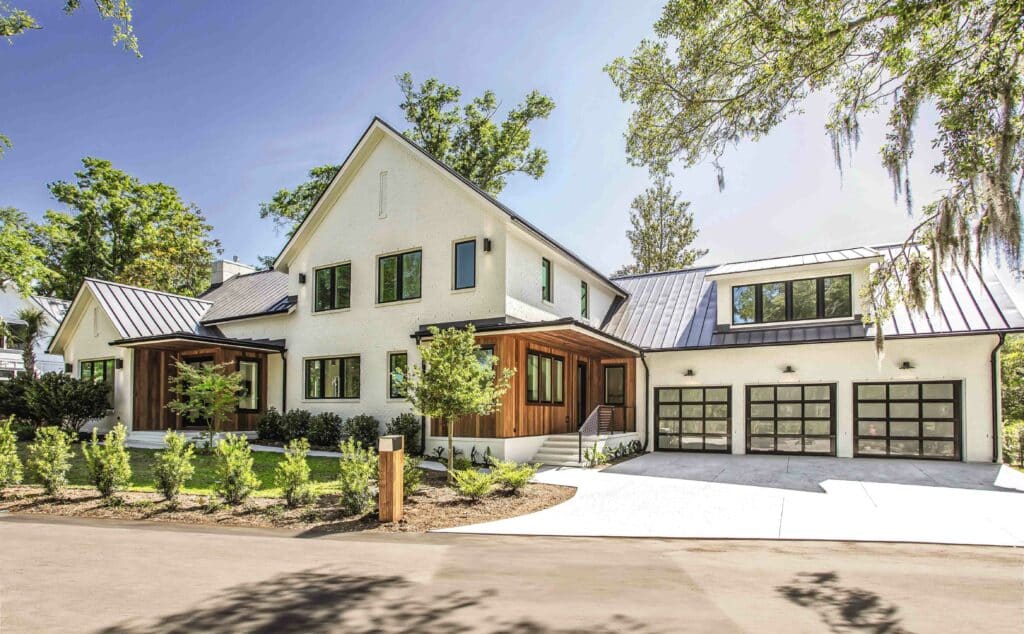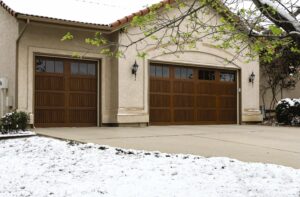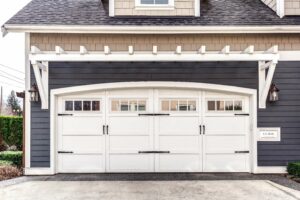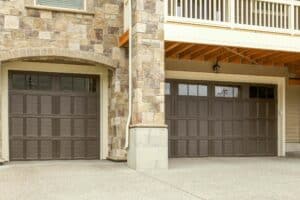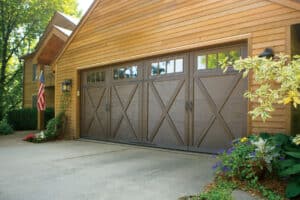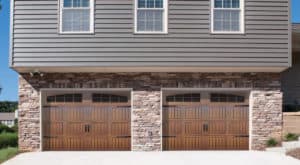Garage doors are complex systems that play a critical role in home security and convenience. This section provides an overview of garage door components, explaining how they function together to provide smooth and reliable operation. Understanding these elements can help homeowners make informed decisions regarding maintenance and upgrades.
Major Components of a Garage Door
Door Panels: Structure and Material Varieties
Garage door panels serve a dual purpose: they are integral to the door’s operation and significantly influence the aesthetic appeal of your home. These panels are the most visible part of the garage door and can be tailored to complement your home’s exterior. Let’s explore the different materials commonly used for these panels and discuss their specific benefits and considerations.
- Wood: Wood panels offer a classic, timeless look that many homeowners appreciate. They can be custom-stained or painted to match any home’s exterior. However, wood requires more maintenance than other materials, as it is susceptible to warping and rotting if not properly treated and maintained.
- Steel: Steel garage door panels are known for their durability and strength, making them a popular choice for both residential and commercial properties. They are less likely to warp or crack compared to wood and require less maintenance. Steel doors can also be insulated to improve energy efficiency, but they can be susceptible to rust in humid or coastal environments unless they are coated with rust-resistant paint.
- Fiberglass: Fiberglass panels are lightweight and resistant to effects of salt air, making them an excellent choice for coastal areas. They can mimic the texture and look of wood without the associated maintenance. While fiberglass is good at resisting dents and damage, it can become brittle over time, especially in cold climates.
- Aluminum: Aluminum garage door panels are another lightweight option that resists rust and corrosion better than steel. They are ideal for large garage doors as their light weight puts less strain on the operating mechanism. Aluminum can be more expensive than steel and is prone to dents.
Each material offers distinct advantages and potential drawbacks, depending on your specific needs and environmental conditions. When choosing the right material for your garage door panels, consider factors such as durability, maintenance requirements, aesthetic preferences, and insulation properties. By selecting the appropriate material, you not only enhance the curb appeal of your home but also ensure the longevity and efficiency of your garage door system.
Opening Mechanism: How Garage Doors Move
Selecting the appropriate garage door opener is essential for ensuring efficient and reliable operation. The type of opener you choose can affect the noise level, speed, and durability of your garage door system. Here are the most common types of garage door openers and what makes each unique:
- Chain-Drive Openers: These are among the most popular and cost-effective options. Chain-drive openers use a metal chain to pull or push a trolley that moves the garage door up and down. While they are known for their reliability and longevity, they tend to be noisier than other types, making them a less ideal choice for garages that are adjacent to or below living areas.
- Belt-Drive Openers: Belt-drive systems operate similarly to chain-drive systems but use a belt instead of a chain, which significantly reduces noise during operation. These are perfect for homes with attached garages, as they operate almost silently. The belts can be made of fiberglass, steel-reinforced rubber, or polyurethane.
- Screw-Drive Openers: Screw-drive systems use a threaded steel rod to move the trolley that opens and closes the garage door. These openers are quieter than chain-drive systems and are known for their speed and strength. Screw-drive openers require less maintenance because they have fewer moving parts, but they can be sensitive to temperature fluctuations.
Each type of garage door opener offers distinct advantages and potential drawbacks, and the right choice often depends on your specific needs, including the level of noise you can tolerate, your budget, and the need for maintenance.
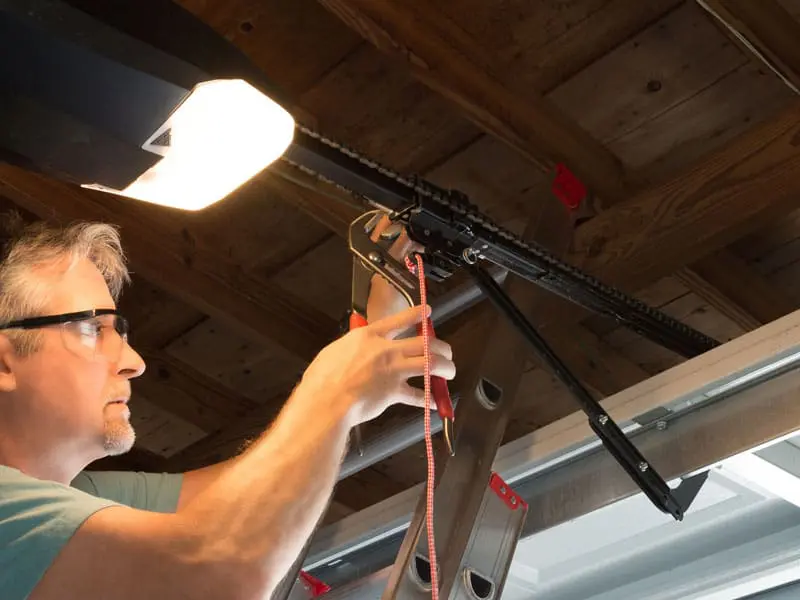
The Role of Springs in Garage Doors
Garage door springs play a critical role in the safe and efficient operation of the door. They counterbalance the weight of the door, making it lighter to lift manually or by the opener. Understanding the types of springs used in garage doors is crucial for maintenance and safety:
- Torsion Springs: These springs are mounted above the garage door opening and twist to provide lifting power. Torsion springs are known for their efficiency and balance, making them suitable for heavier or larger doors. They typically last longer and provide smoother operation.
- Extension Springs: Extension springs are mounted on either side of the door and stretch out as the door is closed. They are more common on lighter doors and are generally cheaper than torsion springs. However, extension springs require more maintenance and safety cables to prevent them from becoming projectiles if a break occurs.
Understanding these components helps in selecting the right type of garage door system and ensuring its long-term functionality and safety. Regular maintenance checks and understanding the fundamental mechanics of your garage door can greatly reduce the risk of accidents and extend the lifespan of the door.
The Supporting Framework
Tracks and Rollers: Ensuring Smooth Motion
The smooth operation of a garage door largely depends on the tracks and rollers that guide it. Tracks are typically made of metal and are attached to the walls of the garage, providing a path for the rollers to move along. Rollers are wheels that are fitted into the track, allowing the door to glide easily when opening or closing.
- Proper Alignment: One of the most critical factors in ensuring the longevity and smooth operation of garage doors is the alignment of the tracks. Misaligned tracks can cause resistance in door movement, leading to undue stress on other components and noisy operations. Regular checks can prevent these issues.
- Lubrication: Regular lubrication of rollers and tracks is essential to minimize friction and wear. It helps in keeping the movement smooth and reduces noise. Using the right type of lubricant, such as a silicone-based spray or grease designed for garage doors, can prolong the life of these components.
- Inspection and Maintenance: It’s important to inspect tracks and rollers periodically for signs of wear, such as bends in the tracks or worn-out rollers. Replacing damaged or worn components promptly can prevent more extensive problems down the line.
Cables and Pulleys: The Lifting Force
Cables and pulleys are integral to the lifting mechanism of a garage door. These components work in tandem to balance and lift the door safely and efficiently.
- Function of Cables and Pulleys: Garage door cables are attached to the bottom of the door and run through a system of pulleys. As the door is opened, the cables wind and unwind from the pulleys, either raising or lowering the door. This system significantly reduces the effort needed to move the door.
- Regular Checks and Maintenance: Due to the high tension under which these cables operate, they are prone to wear and tear. Fraying or rusted cables can be hazardous and may snap under strain. Regular inspection and replacement of worn cables are crucial for safety and proper door operation.
- Importance of Pulleys: Pulleys must be in good working condition to ensure the cables can move smoothly. Worn pulleys can cause cables to fray or get caught, potentially leading to dangerous situations. Like cables, pulleys should be inspected regularly and replaced if they show signs of wear.
Understanding the role of tracks, rollers, cables, and pulleys in your garage door system and maintaining these parts can help ensure that your garage door operates smoothly and reliably for years to come. Regular maintenance not only extends the life of these components but also ensures the safety of users and the security of the property.
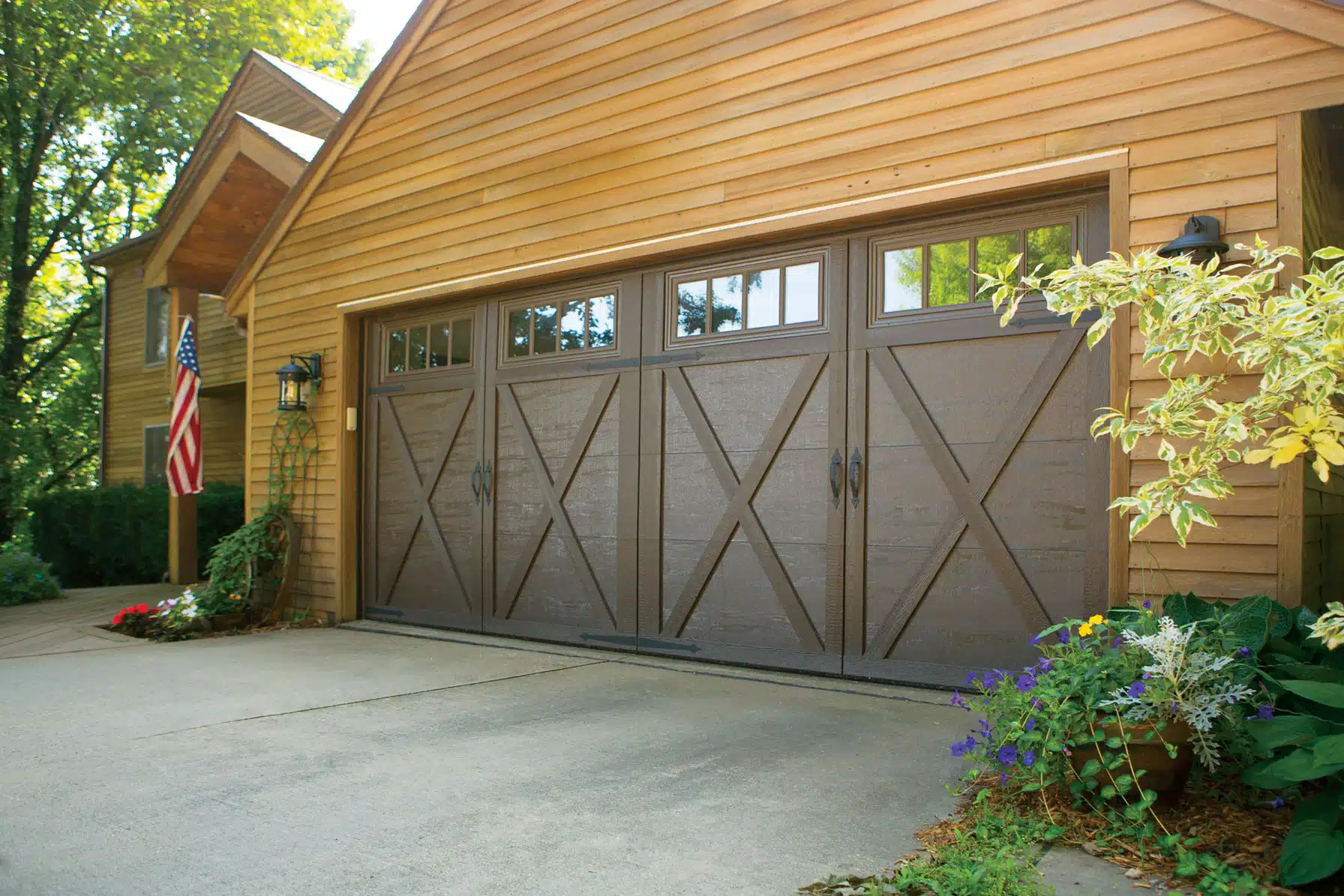
Aesthetic and Functional Enhancements
Window Inserts and Decorative Hardware
Enhancing the visual appeal of your garage door can significantly impact the overall aesthetic of your home. Here are two ways to achieve this:
- Window Inserts: Incorporating window inserts into your garage door design offers several benefits. They allow natural light to filter into what can often be a dimly lit space, making it easier to use the garage during the day without additional lighting. From a design perspective, window inserts come in various styles, such as frosted, clear, or tinted glass, and can be arranged in multiple patterns to complement the architecture of your home. Not only do they beautify the door, but they also add a level of customization that can enhance your home’s curb appeal.
- Decorative Hardware: Adding decorative hardware is another way to elevate the appearance of your garage door. Options like wrought iron hinges, handles, and straps can mimic the look of classic carriage doors, adding a rustic or vintage charm. These elements are purely aesthetic but are key to creating a custom look that stands out in the neighborhood.
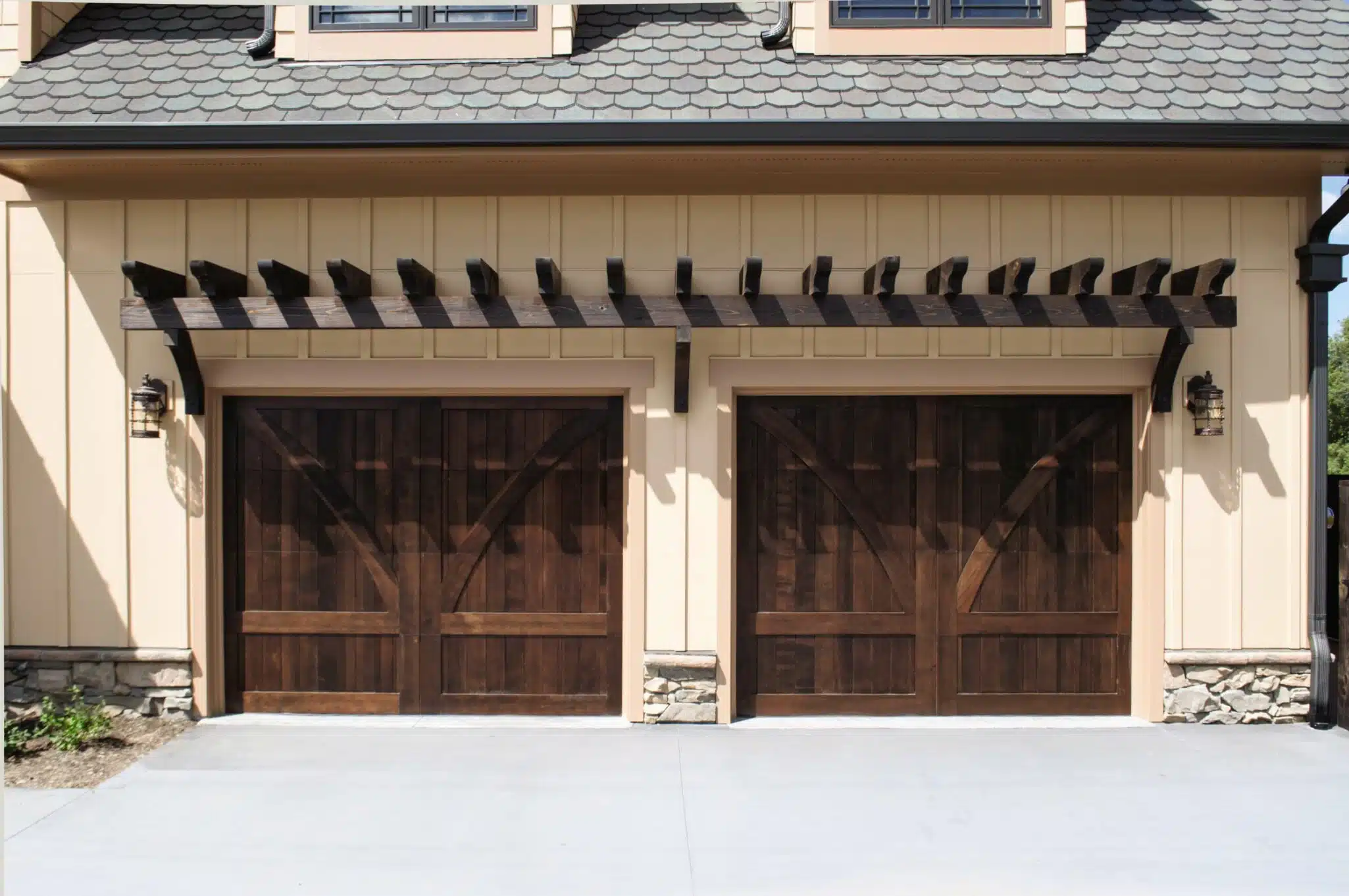
Weather Seals and Insulation: Protecting Against Elements
Beyond aesthetics, functional enhancements like weather seals and insulation play critical roles in the efficiency and durability of your garage door:
- Weather Seals: Weather seals are fitted along the bottom edge, sides, and top of the garage door. They serve to protect against water, wind, and debris by sealing the gaps around the door. This is especially important in areas prone to severe weather conditions, as it prevents elements from entering the garage and potentially damaging its contents. In addition, seals help to block drafts, which can keep the garage—and adjacent home areas—more temperature-controlled and comfortable.
- Insulation: Properly insulating your garage door is crucial for energy efficiency, particularly if your garage is attached to your home or if you use the space as a workshop or living area. Insulation helps maintain a consistent temperature inside the garage, reducing the energy required to heat or cool it. This can lead to significant savings on energy bills, especially in extreme weather conditions. There are various insulation options available, such as polystyrene and polyurethane, each providing different levels of thermal resistance. The choice of insulation should align with your climate and how you use your garage.
Combining aesthetic upgrades with functional improvements not only enhances the appearance of your garage door but also contributes to a more secure, comfortable, and energy-efficient home environment. These enhancements make your garage an integral part of your home’s appeal and functionality, reflecting personal style while catering to practical needs.
FAQs
The main components include door panels, opening mechanism, springs, tracks and rollers, and the supporting framework which involves cables and pulleys.
Common materials include wood (classic appearance, customizable), steel (durable, low maintenance), fiberglass (lightweight, good for coastal areas), and aluminum (rust-resistant, ideal for large doors).
Consider durability, maintenance needs, aesthetic preferences, and insulation properties to ensure longevity and enhance your home’s curb appeal.
Chain-drive openers are durable but noisy; belt-drive openers are quiet, ideal for attached garages; screw-drive openers are fast and low-maintenance but sensitive to temperature changes.
Springs help counterbalance the door’s weight, making it easier to operate. Torsion springs offer a smoother operation for heavier doors, while extension springs are suitable for lighter doors but require more maintenance.
Regular maintenance such as proper alignment, lubrication of tracks and rollers, and checking for wear and tear are crucial for smooth and efficient operation.
Cables and pulleys help lift the door efficiently and safely. Regular checks for wear and tear, and replacing any frayed or damaged parts are essential for safe operation.
Adding window inserts can bring natural light and aesthetic appeal, while decorative hardware like wrought iron hinges can give a vintage look to your garage door.
Weather seals protect against elements and drafts, enhancing comfort and preventing damage. Insulation improves energy efficiency, keeping the garage and adjacent areas temperature-controlled.
Regular maintenance ensures safe operation, extends the lifespan of components, and prevents accidents and potential breakdowns.

